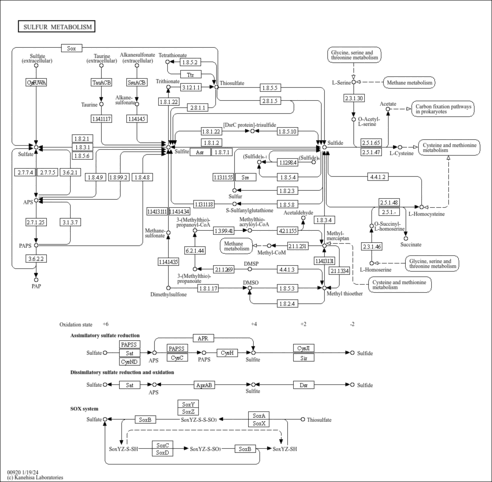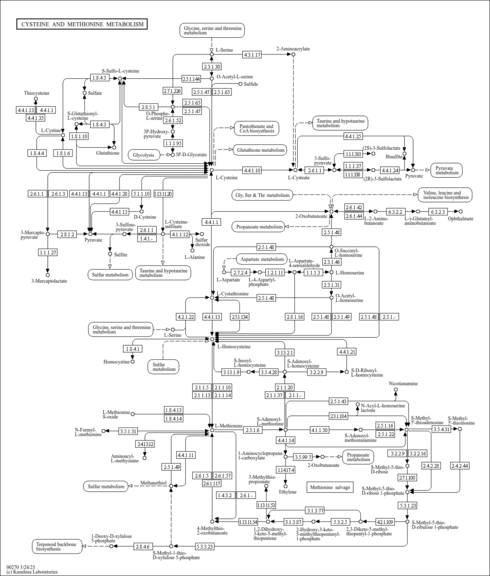| GC-MS Spectra| Spectrum Type | Description | Splash Key | Deposition Date | Source | View |
|---|
| Predicted GC-MS | Predicted GC-MS Spectrum - Sulfite GC-MS (Non-derivatized) - 70eV, Positive | splash10-001i-9000000000-6e01fa26fbebd72ad6ac | 2017-09-01 | Wishart Lab | View Spectrum | | Predicted GC-MS | Predicted GC-MS Spectrum - Sulfite GC-MS (Non-derivatized) - 70eV, Positive | Not Available | 2021-10-12 | Wishart Lab | View Spectrum |
MS/MS Spectra| Spectrum Type | Description | Splash Key | Deposition Date | Source | View |
|---|
| Experimental LC-MS/MS | LC-MS/MS Spectrum - Sulfite Quattro_QQQ 10V, Positive-QTOF (Annotated) | splash10-0ue9-9000000000-f7ae469c0c0eb80e5bb9 | 2018-05-15 | HMDB team, MONA | View Spectrum | | Experimental LC-MS/MS | LC-MS/MS Spectrum - Sulfite Quattro_QQQ 25V, Positive-QTOF (Annotated) | splash10-001i-9300000000-8bbaba610a5e9ef617fe | 2018-05-15 | HMDB team, MONA | View Spectrum | | Experimental LC-MS/MS | LC-MS/MS Spectrum - Sulfite Quattro_QQQ 40V, Positive-QTOF (Annotated) | splash10-0udi-9300000000-460847a9238bf81b4b9c | 2018-05-15 | HMDB team, MONA | View Spectrum | | Predicted LC-MS/MS | Predicted LC-MS/MS Spectrum - Sulfite 10V, Positive-QTOF | splash10-001i-9000000000-0d5af2beca96b50eac8a | 2015-09-14 | Wishart Lab | View Spectrum | | Predicted LC-MS/MS | Predicted LC-MS/MS Spectrum - Sulfite 20V, Positive-QTOF | splash10-001i-9000000000-42884a642ace9e213e65 | 2015-09-14 | Wishart Lab | View Spectrum | | Predicted LC-MS/MS | Predicted LC-MS/MS Spectrum - Sulfite 40V, Positive-QTOF | splash10-01q9-9000000000-5357c61e80aaefe2133c | 2015-09-14 | Wishart Lab | View Spectrum | | Predicted LC-MS/MS | Predicted LC-MS/MS Spectrum - Sulfite 10V, Negative-QTOF | splash10-001i-9000000000-a7737b78e8d12bda4559 | 2015-09-15 | Wishart Lab | View Spectrum | | Predicted LC-MS/MS | Predicted LC-MS/MS Spectrum - Sulfite 20V, Negative-QTOF | splash10-001i-9000000000-1920e0308a2b8b74a3f4 | 2015-09-15 | Wishart Lab | View Spectrum | | Predicted LC-MS/MS | Predicted LC-MS/MS Spectrum - Sulfite 40V, Negative-QTOF | splash10-001i-9000000000-1920e0308a2b8b74a3f4 | 2015-09-15 | Wishart Lab | View Spectrum | | Predicted LC-MS/MS | Predicted LC-MS/MS Spectrum - Sulfite 10V, Negative-QTOF | splash10-001i-9000000000-a6fb8cd4d3dc149be309 | 2021-09-24 | Wishart Lab | View Spectrum | | Predicted LC-MS/MS | Predicted LC-MS/MS Spectrum - Sulfite 20V, Negative-QTOF | splash10-001i-9000000000-a6fb8cd4d3dc149be309 | 2021-09-24 | Wishart Lab | View Spectrum | | Predicted LC-MS/MS | Predicted LC-MS/MS Spectrum - Sulfite 40V, Negative-QTOF | splash10-001i-9000000000-a6fb8cd4d3dc149be309 | 2021-09-24 | Wishart Lab | View Spectrum | | Predicted LC-MS/MS | Predicted LC-MS/MS Spectrum - Sulfite 10V, Positive-QTOF | splash10-001i-9000000000-95d8eaf2b829c52ced6c | 2021-09-24 | Wishart Lab | View Spectrum | | Predicted LC-MS/MS | Predicted LC-MS/MS Spectrum - Sulfite 20V, Positive-QTOF | splash10-03di-9000000000-2c4a3db8921d94d7f526 | 2021-09-24 | Wishart Lab | View Spectrum | | Predicted LC-MS/MS | Predicted LC-MS/MS Spectrum - Sulfite 40V, Positive-QTOF | splash10-03di-9000000000-2c4a3db8921d94d7f526 | 2021-09-24 | Wishart Lab | View Spectrum |
IR Spectra| Spectrum Type | Description | Deposition Date | Source | View |
|---|
| Predicted IR Spectrum | IR Ion Spectrum (Predicted IRIS Spectrum, Adduct: [M-H]-) | 2023-02-03 | FELIX lab | View Spectrum | | Predicted IR Spectrum | IR Ion Spectrum (Predicted IRIS Spectrum, Adduct: [M+H]+) | 2023-02-03 | FELIX lab | View Spectrum | | Predicted IR Spectrum | IR Ion Spectrum (Predicted IRIS Spectrum, Adduct: [M+Na]+) | 2023-02-03 | FELIX lab | View Spectrum |
| Show more...
|---|
| General References | - Graf WD, Oleinik OE, Jack RM, Weiss AH, Johnson JL: Ahomocysteinemia in molybdenum cofactor deficiency. Neurology. 1998 Sep;51(3):860-2. [PubMed:9748040 ]
- Jeppesen C: Media for Aeromonas spp., Plesiomonas shigelloides and Pseudomonas spp. from food and environment. Int J Food Microbiol. 1995 Jun;26(1):25-41. [PubMed:7662518 ]
- Mitsuhashi H, Nojima Y, Tanaka T, Ueki K, Maezawa A, Yano S, Naruse T: Sulfite is released by human neutrophils in response to stimulation with lipopolysaccharide. J Leukoc Biol. 1998 Nov;64(5):595-9. [PubMed:9823763 ]
- von Graevenitz A, Bucher C: Evaluation of differential and selective media for isolation of Aeromonas and Plesiomonas spp. from human feces. J Clin Microbiol. 1983 Jan;17(1):16-21. [PubMed:6826700 ]
- Tsariuk LA, Rybachuk VN, Shevchenko LI, Tolstykh VM: [Determination of fibrinogen concentration in blood plasma by the sulfite precipitation method]. Vopr Med Khim. 1979 Jan-Feb;25(1):97-101. [PubMed:425377 ]
- Shea M, Howell S: High-performance liquid chromatographic measurement of exogenous thiosulfate in urine and plasma. Anal Biochem. 1984 Aug 1;140(2):589-94. [PubMed:6486442 ]
- Bor-Kucukatay M, Kucukatay V, Agar A, Baskurt OK: Effect of sulfite on red blood cell deformability ex vivo and in normal and sulfite oxidase-deficient rats in vivo. Arch Toxicol. 2005 Sep;79(9):542-6. Epub 2005 Apr 13. [PubMed:15827731 ]
- Gubash SM, Ingham L: Comparison of a new, bismuth-iron-sulfite-cycloserine agar for isolation of Clostridium perfringens with the tryptose-sulfite-cycloserine and blood agars. Zentralbl Bakteriol. 1997 Feb;285(3):397-402. [PubMed:9084113 ]
- Kim E, Driscoll CF, Minah GE: The effect of a denture adhesive on the colonization of Candida species in vivo. J Prosthodont. 2003 Sep;12(3):187-91. [PubMed:14508740 ]
- Willis CL, Cummings JH, Neale G, Gibson GR: Nutritional aspects of dissimilatory sulfate reduction in the human large intestine. Curr Microbiol. 1997 Nov;35(5):294-8. [PubMed:9462959 ]
- Sardesai VM: Molybdenum: an essential trace element. Nutr Clin Pract. 1993 Dec;8(6):277-81. [PubMed:8302261 ]
- Togawa T, Ogawa M, Nawata M, Ogasawara Y, Kawanabe K, Tanabe S: High performance liquid chromatographic determination of bound sulfide and sulfite and thiosulfate at their low levels in human serum by pre-column fluorescence derivatization with monobromobimane. Chem Pharm Bull (Tokyo). 1992 Nov;40(11):3000-4. [PubMed:1477915 ]
- Pearson SJ, Czudek C, Mercer K, Reynolds GP: Electrochemical detection of human brain transmitter amino acids by high-performance liquid chromatography of stable o-phthalaldehyde-sulphite derivatives. J Neural Transm Gen Sect. 1991;86(2):151-7. [PubMed:1683240 ]
- Mishra A, Dayal N, Beck-Speier I: Effect of sulphite on the oxidative metabolism of human neutrophils: studies with lucigenin- and luminol-dependent chemiluminescence. J Biolumin Chemilumin. 1995 Jan-Feb;10(1):9-19. [PubMed:7762419 ]
- Beck-Speier I, Lenz AG, Godleski JJ: Responses of human neutrophils to sulfite. J Toxicol Environ Health. 1994 Mar;41(3):285-97. [PubMed:8126751 ]
- Beck-Speier I, Liese JG, Belohradsky BH, Godleski JJ: Sulfite stimulates NADPH oxidase of human neutrophils to produce active oxygen radicals via protein kinase C and Ca2+/calmodulin pathways. Free Radic Biol Med. 1993 Jun;14(6):661-8. [PubMed:8392022 ]
- Zhang X, Vincent AS, Halliwell B, Wong KP: A mechanism of sulfite neurotoxicity: direct inhibition of glutamate dehydrogenase. J Biol Chem. 2004 Oct 8;279(41):43035-45. Epub 2004 Jul 23. [PubMed:15273247 ]
- Tan WH, Eichler FS, Hoda S, Lee MS, Baris H, Hanley CA, Grant PE, Krishnamoorthy KS, Shih VE: Isolated sulfite oxidase deficiency: a case report with a novel mutation and review of the literature. Pediatrics. 2005 Sep;116(3):757-66. [PubMed:16140720 ]
- Karakas E, Kisker C: Structural analysis of missense mutations causing isolated sulfite oxidase deficiency. Dalton Trans. 2005 Nov 7;(21):3459-63. Epub 2005 Sep 26. [PubMed:16234925 ]
- Lester MR: Sulfite sensitivity: significance in human health. J Am Coll Nutr. 1995 Jun;14(3):229-32. [PubMed:8586770 ]
- Veldman A, Santamaria-Araujo JA, Sollazzo S, Pitt J, Gianello R, Yaplito-Lee J, Wong F, Ramsden CA, Reiss J, Cook I, Fairweather J, Schwarz G: Successful treatment of molybdenum cofactor deficiency type A with cPMP. Pediatrics. 2010 May;125(5):e1249-54. doi: 10.1542/peds.2009-2192. Epub 2010 Apr 12. [PubMed:20385644 ]
- (). Yannai, Shmuel. (2004) Dictionary of food compounds with CD-ROM: Additives, flavors, and ingredients. Boca Raton: Chapman & Hall/CRC.. .
| Show more...
|---|

